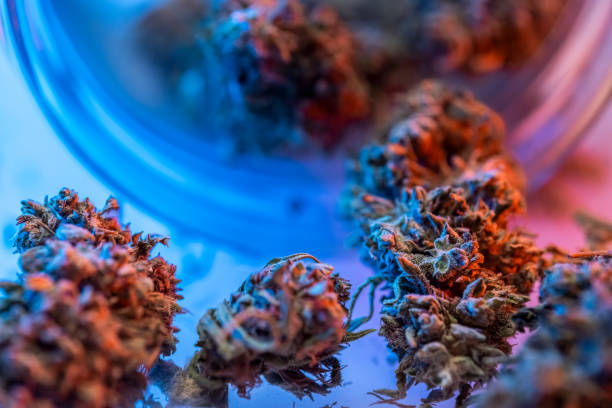How to Grow Dense Buds for a Superior Cannabis Experience
02-13-2025
This comprehensive guide dives deep into the world of cannabis bud development, focusing specifically on bud density and its critical role in the overall quality of your weed. Discover the factors that influence bud density, from strain selection to environmental controls, and learn the best practices for achieving those prized, dense bud harvests. This guide is a must-read for both novice and experienced cannabis growers aiming to cultivate top-shelf buds.
1. What is Bud Density, and Why Does it Matter?
Bud density, or the density of cannabis buds, refers to how compact and solid the buds are. It is a key factor in determining the overall quality and desirability of the cannabis. Bud density refers to the relationship between the mass and the volume of a bud. Dense bud will feel heavier for its size and offer a more satisfying experience.
High bud density is often associated with higher potency, better flavor, and a more pleasing visual appeal. Dense buds are often preferred by consumers because they tend to be more potent and burn more evenly, which leads to a superior smoking or vaping experience. Therefore, understanding and optimizing for bud density is critical for any cannabis grower seeking to produce high-quality buds.
For many, the density of cannabis buds is seen as a benchmark of excellence in cultivation practices. Whether you're aiming for a superior experience for yourself or producing quality cannabis for sale, understanding how to cultivate dense buds is essential.

2. What are the Common Factors That Impact Bud Density?
Several factors influence the density of your cannabis buds, impacting their quality and overall appeal. Understanding these factors is crucial for any grower.
Genetics: The strain of cannabis you grow has a major impact on bud density. Some strains are naturally predisposed to produce dense buds, while others tend to be lighter and more airy. The genetic makeup of the cannabis plant sets the foundation for the buds it will eventually produce.
Light: Adequate and intense lighting is vital for bud development. Cannabis needs plenty of light to photosynthesize, creating the energy required for buds to swell and become dense. Insufficient or weak lighting can result in airy buds.
Nutrients: Proper nutrient management plays a vital role. Cannabis requires specific nutrients throughout the flowering stage to support bud growth and density. Deficiencies or imbalances can hinder bud development.
Environment: The environment, including temperature, humidity, and airflow, affects bud density. A controlled environment allows you to optimize these parameters for maximum bud development.
Watering: Overwatering can lead to a lack of oxygen in the roots, impacting the plant's ability to absorb nutrients and affecting bud growth. Proper watering techniques are essential.
Stress: Minimizing stress on the cannabis plant is important. Environmental stresses can divert the plant's energy away from bud development.
3. How Does Strain Selection Influence Bud Density?
Strain selection is arguably the most fundamental factor determining bud density. Different cannabis strains exhibit varying genetic predispositions for bud structure and compactness. Some strains are inherently more likely to produce dense buds, while others tend to develop a looser, more airy structure.
When choosing a strain to grow, research its genetic lineage and reputation. Look for strains known for producing dense cannabis buds. Information about strain characteristics is readily available from seed banks, cannabis breeders, and online resources. Consider researching different cannabis strains before you get started.
Consider the following:
- Indica Strains: Indica-dominant strains are often associated with producing dense buds.
- Hybrid Strains: Many hybrid strains offer a balance of qualities, including the potential for dense bud development.
- Sativa Strains: Sativa-dominant strains are often known for more airy buds, though some can still produce respectable density.
I know from experience that certain strains consistently deliver dense buds under the right conditions, offering a more reliable path to quality buds.
4. How do Growing Conditions Affect Bud Density?
Beyond strain selection, the grow conditions profoundly influence bud density. Controlling the environment provides the optimal conditions for your cannabis plant to thrive and produce dense buds.
- Lighting: Ensure the cannabis plant receives sufficient light intensity, particularly during the flowering stage. High-intensity discharge (HID) lights, LED grow lights, or other advanced lighting systems can contribute to bud density.
- Temperature: Maintain an ideal temperature range. Moderate temperatures typically promote better bud development. Avoid extreme temperature fluctuations, as they can stress the plant.
- Humidity: Humidity levels play a significant role, especially during the flowering stage. Too much humidity can lead to mold and mildew, while too little can dry out the buds.
- Airflow: Provide adequate airflow to prevent stagnant air and promote healthy growth. Good airflow also helps to prevent the development of mold.
- Nutrients: Feed the cannabis plant a balanced nutrient solution tailored for the flowering stage. Proper nutrient ratios promote healthy bud development.
- Watering: Avoid overwatering or underwatering the plant. Consistent moisture levels promote optimal bud growth.
Creating a stable, optimized grow room environment can significantly impact the density of your buds. Monitoring and adjusting these factors throughout the flowering stage will help maximize your yield of dense cannabis.

5. How Does the Harvest Process Affect Bud Quality and Density?
The harvest process, including the harvest time and methods, can drastically affect the final bud density and quality. Therefore, the decisions you make at harvest are crucial.
- Harvest Time: The harvest time is critical. Harvesting too early or too late can impact bud development. Observe the trichomes (tiny, crystal-like structures on the buds) and monitor their color.
- Proper Drying and Curing: After harvest, the buds must be properly dried and cured. This process removes moisture and allows the buds to develop their flavor and potency.
- Trimming: Trimming the buds removes excess leaves and promotes a more appealing appearance. Proper trimming also contributes to increased bud density by removing excess foliage.
- Storage: The way you store your harvest can either preserve or diminish bud density. Store your buds in an airtight container in a cool, dark place.
I've learned that paying close attention to detail during the harvest phase ensures the buds retain their maximum quality, density, and potency. Careful handling and adherence to best practices during this stage can significantly impact the final product.
6. What are the Characteristics of Dense Buds vs. Fluffy Buds?
Understanding the key differences between dense buds and fluffy buds is essential for assessing the quality of your cannabis. Recognizing these characteristics will help you better understand the results of your cannabis cultivation.
Dense Buds:
- Appearance: Dense buds are compact and tightly packed with cannabis flowers. They often appear solid, with minimal gaps between the individual calyxes (the parts of the buds that contain the cannabis flowers).
- Weight: Dense buds are heavier than their size suggests. They feel substantial in your hand.
- Texture: Dense buds are firm to the touch, with a slight resistance when squeezed.
- Aroma: Dense buds often have a strong, complex aroma, indicating the presence of abundant terpenes.
- Smoke: Dense buds often burn slowly and evenly, producing a smooth and flavorful smoke.
Fluffy Buds:
- Appearance: Fluffy buds are more airy and less compact. They have noticeable gaps between the calyxes, creating a loose structure.
- Weight: Fluffy buds feel lighter for their size.
- Texture: Fluffy buds are often soft and may crumble easily.
- Aroma: Fluffy buds may have a weaker aroma, suggesting lower terpene content.
- Smoke: Fluffy buds tend to burn quickly and unevenly, often producing a harsh smoke.
The goal of any grower is to cultivate dense buds, as they are generally associated with higher potency and superior quality.
7. How Can You Avoid Airy or Fluffy Buds?
Preventing the development of airy or fluffy buds is a proactive process that begins early in the cannabis cultivation process. Addressing potential issues and implementing preventative measures can dramatically improve the bud's density.
- Genetics: Choose strains known for producing dense buds.
- Light: Ensure the cannabis plant receives adequate and intense light throughout the flowering stage.
- Environment: Maintain optimal environmental conditions: consistent temperatures, humidity, and airflow.
- Nutrients: Feed the plant a balanced nutrient solution, avoiding deficiencies or excesses.
- Avoid Overwatering: Overwatering can stress the plant and lead to poor bud development.
- Minimize Stress: Reduce stress from pests, diseases, or environmental factors.
- Proper Drying and Curing: Adhere to proper drying and curing protocols to preserve bud density.
- Monitor and Adjust: Regularly monitor your grow room and make necessary adjustments to optimize conditions.
By addressing these issues and carefully managing the cannabis plant's environment and nutrition, you can drastically reduce the likelihood of producing airy flowers.
8. How to Improve Bud Density in an Existing Grow?
If you are already mid-grow and notice your buds are less dense than you'd hoped, there are steps you can take to try and improve the situation. While some issues can be addressed, there are limitations to what you can do in the later stages of the flowering stage.
- Optimize Lighting: Ensure your plants receive the maximum possible light intensity. Consider supplementing your lighting if it's not sufficient.
- Review Nutrients: Check that the nutrient solution is appropriate for the flowering stage and that there are no deficiencies.
- Adjust Environment: Fine-tune the temperature, humidity, and airflow. Be careful not to stress the plant with rapid environmental changes.
- Proper Watering: Ensure the plant receives proper watering and that the roots are healthy.
- Provide Support: Provide physical support to the buds if they are drooping due to their size.
- Observe and Adapt: Watch your plants carefully, and adjust your approach based on their response.
Realistically, you may have limited options to increase bud density in an existing grow. However, taking these steps may improve the final product and inform your approach in future grows.
9. Is Bud Density Always an Indicator of Quality Cannabis?
While bud density is a good indicator of cannabis quality, it is not the only factor. Other aspects contribute to the overall experience, including potency, flavor, and aroma.
- Potency: Testing the cannabis for cannabinoid content can provide an objective measurement of potency.
- Terpenes: Terpenes contribute to the flavor and aroma profile of the cannabis. Evaluate these for the overall quality.
- Appearance: Examine the visual appearance of the buds, including the color, trichome coverage, and overall cleanliness.
- Effects: Ultimately, the effects experienced by the user are a crucial measure of cannabis quality.
While dense buds tend to be of high quality, it is crucial to consider the total package. A less dense bud with outstanding terpenes and potency may be preferable to a super-dense bud with poor flavor.
10. Conclusion: Mastering the Art of Growing Dense Buds.
Cultivating dense buds is a combination of art and science. It requires attention to detail, an understanding of cannabis genetics, and a commitment to optimizing the growing environment. However, the reward is a superior product that delivers an enhanced consumer experience.
Remember these key points:
- Strain Selection Matters: Choose strains with a reputation for producing dense buds.
- Optimize Your Environment: Create a stable environment with adequate light, temperature, humidity, and airflow.
- Provide Proper Nutrition: Feed the cannabis plant a balanced nutrient solution.
- Practice Careful Watering: Avoid overwatering and underwatering.
- Prioritize Harvest Timing: Harvest at the peak harvest time.
- Dry and Cure Properly: Adhere to proper drying and curing protocols.
By mastering these techniques, you can increase the yield, quality, and overall appeal of your cannabis buds. Learning to grow dense buds is a journey of continuous learning, observation, and adaptation. Each grow brings new insights, and by constantly refining your approach, you can achieve the densest buds.








